Does Hemlock Come Up In Gardens Colorado
A toxic invasive species that can be deadly if eaten is spreading, wrecking havoc across parks, flower beds and backyard gardens.
Poison hemlock, which resembles Queen Anne's Lace, can be spotted in highway right-of-ways, along fences and on the edges of farm fields. In just the last year, however, the plant that was originally brought to the U.S. from Europe has migrated near more populated areas, which has experts concerned.
"That movement is a bit scary to me because this plant is very toxic and it's more of an opportunity for kids to play with it and pets to eat it," said Dan Shaver with Indiana's Natural Resources Conservation Service. "It is not a plant you want around your home or in your local park."
The toxic biennial can be found in nearly every state in the U.S., according to the National Park Service.
This is the time of year that poison hemlock spreads and grows its footprint. Each plant produces a lot of seeds — up to 30,000 — that ripen between late June and August after it flowers. Those seeds are easily scattered during late summer mowing, Shaver said.
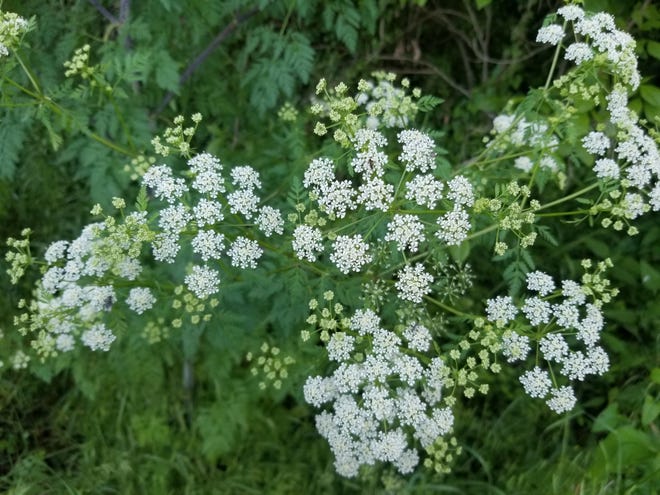
It loves to find those little pockets that are unmanaged, whether that's a street corner not getting mowed or a pollinator habitat growing wild in a neighborhood.
Poison hemlock also does well in moist soil conditions, Shaver said. So with the wet springs the Midwest has seen, it's been the perfect environment for the toxic plant to explode.
"It just hit this exponential rate of spread," Shaver said. "Poison hemlock was nowhere and all of a sudden it was everywhere."
Kevin Tungesvick, a senior ecologist with Eco Logic, an environmental restoration company, said in Indiana, the plant has spread too broadly to be eradicated from the state.
Short of that, he said, the goal is to try to manage and control poison hemlock to the maximum extent possible — to protect both environmental and public health.
In June, Jason Hartschuh of the Ohio State University Extension said the hazardous plant was appearing "everywhere" in Ohio – more visible this year than ever before.
Here's what you need to know about this deadly plant, including the toxic effects it can have, how to spot it and how to get rid of it.
Stop tossing your pet goldfish in lakes:'They grow bigger than you think,' officials warn
How poison hemlock makes you sick
Like any invasive species, poison hemlock can out-compete and displace native species, Shaver said, which certainly is of concern. But the real issue, in this case, is when it crowds into areas where people, pets or livestock could come into contact with it.
All parts of the plant are poisonous from its seeds to the sap, said Dawn Slack with The Nature Conservancy's Indiana chapter.
If the sap from poison hemlock comes into contact with someone's skin, it can react with the sun and cause blisters and welts, according to the U.S. Department of Agriculture.
That's why Slack recommends handling poison hemlock, if there's some that needs to be removed, with gloves, long sleeves and pants as well as eye protection.
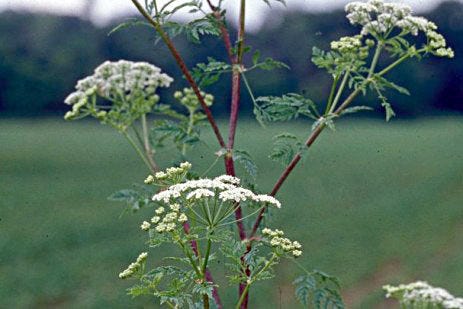
But while the sap can prove dangerous, the true threat is if any part of the plant — stalk and stems, leaves, flowers, seeds or roots — were to be ingested.
Hemlock poisoning can be fatal with no antidote. All plant parts contain toxic alkaloids that can interfere with nerve transmissions to your muscles, ultimately causing respiratory failure.
Other signs of poisoning can include trembling, salivation, pupil dilation, muscle paralysis and loss of speech.
Symptoms can show as early as just 30 minutes after ingesting it, and the severity of the poisoning depends on how much was ingested and the concentration of the hemlock was at the time. Still, even small amounts can have serious effects.
"None of this should enter your body," Slack said.
The effects aren't limited to humans. Poison hemlock can be mixed with harmless plants in pastures and crops where livestock may eat it, or in a garden where a dog may munch on the plant.
How to spot poison hemlock
Poison hemlock is part of the parsley and carrot family. Its leaves are easy to confuse with parsley. Its seeds look similar to those of anise and its roots resemble parsnip roots.
This mistaken identity is the main way people are exposed or accidentally poisoned. But there are ways to distinguish poison hemlock that are unique only to it.
Poison hemlock is a biennial plant. In its first year, it puts out a clump of lacy-looking leaves that grow close to the ground. But during the second year, it sends up a flowering stem that can grow as tall as 4-6 feet – and some even taller.
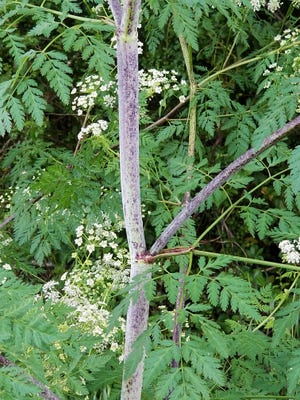
Once it flowers, it looks like a giant Queen Anne's lace, Slack said, adding that it has a beautiful cluster of tiny white flowers at the top. What sets it apart, however, is that the stem is bigger and it's dotted with purple spots all along the stalk.
It can be found along many major roadways, the edge of fields and fences, the banks of streams and in ditches. After two years, the poison hemlock plant will die, but not before it has put out thousands of seeds.
How poison hemlock spreads
Poison hemlock is native to Europe and was brought over to North America many decades ago as a garden plant, desired for its delicate white flowers. But over time, it moved out of gardens and into fields, prairies and other open areas.
Like most invasive species, poison hemlock has been around for a long time, but in small enough populations that no one really noticed. And another hallmark of invasives, poison hemlock doesn't have native competition or predators to help control it.
When hemlock flowers, each plant can produce as many as 30,000 seeds.
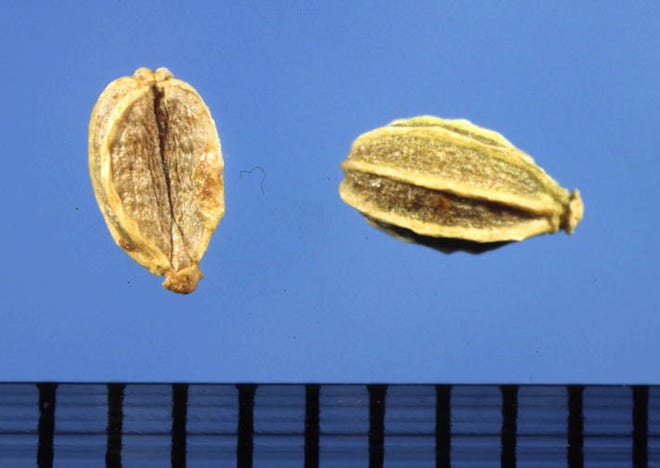
With the right wet and cool conditions and a built-up seed bank, the population can proliferate and explode — past the point where it can be eliminated.
"It's kind of a combination of things," Slack said. "And all of a sudden we're faced with 'we need to do something now.'"
One of the main ways that poison hemlock has been spread is through mowing, Shaver said. The seeds will get caught in mowing equipment or they will get rustled into the air as the plants are mowed over. That's why there is an effort to raise awareness about how to best manage the plant, he added.
One of the 'deadliest plants in the US:More to know about poison hemlock
How to manage poison hemlock
If you spot poison hemlock in a public park or along a road side, Shaver recommends reaching out to the agency in charge of that property to let them know about the plant.
But if you find it in one of your own flower beds or a shared neighborhood space, there are ways you can remove it yourself. First, and most importantly, is to make sure you are wearing protective gear — such as gloves, goggles and long sleeves — before working to control it.
Timing is everything, Tungesvick said – and the best time for management efforts is in the spring.
There are several common and effective herbicides that can be used on the plant, Shaver said. Those should be applied in the early months before the plant flowers.
The same goes for management efforts that don't involve chemicals, such as digging up the poison hemlock. April is the prime month for control, Tungesvick said. It usually is flowering by the end of May and maturing its seeds in July. By then it's too late and there is a greater risk for further exposure or spreading the seed.
Slack recommends going after the poison hemlock in its first year, if you are able to spot the plant when it's still a low cluster of leaves. She said it's best to dig up the entire thing and then set it out in the sun to dry completely. Once it's fully dried, that's when you can discard it.
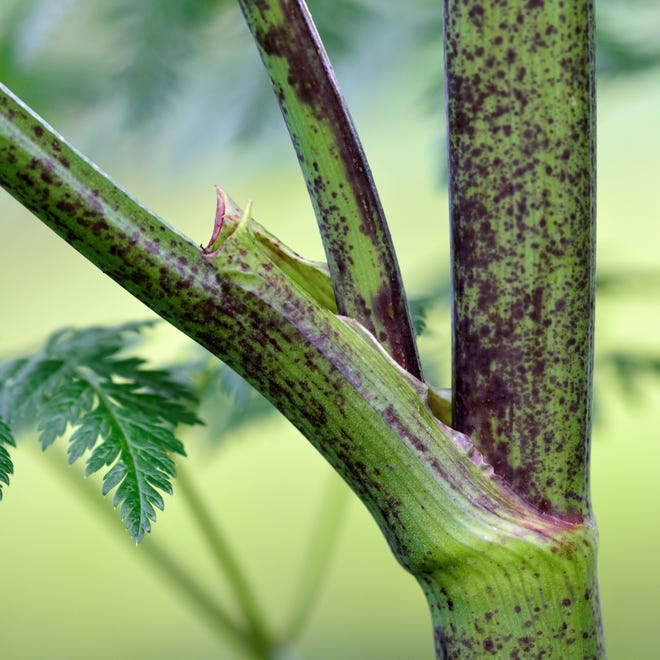
If you aren't able to catch the plant until its stalk bolts up in the second year, then Shaver said you can clip the flowers before it goes to seed and then bag them up.
No matter what, Shaver warns against weed-whipping or mowing the poison hemlock. Not only could that potentially spread the plant, but it can also get its seeds and sap into the air where it can get on your skin or possibly even ingest it.
"It's important to control it," he said, "but it's something that requires a lot of thought and caution before doing so."
Follow Sarah Bowman on Twitter: @IndyStarSarah.
Indianapolis Star environmental reporting project is made possible through the generous support of the nonprofit Nina Mason Pulliam Charitable Trust.
Does Hemlock Come Up In Gardens Colorado
Source: https://www.usatoday.com/story/news/nation/2021/08/03/poison-hemlock-us-parks-gardens-beware-toxic-plant/5465780001/
Posted by: bowleytroses.blogspot.com

0 Response to "Does Hemlock Come Up In Gardens Colorado"
Post a Comment